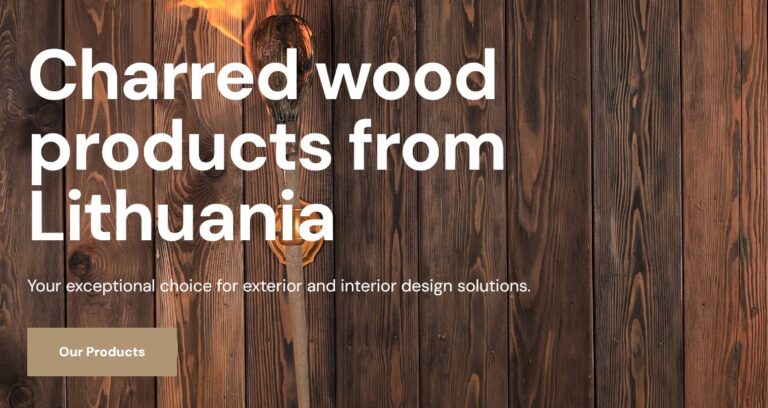Over the last few years, Lithuanian charred wood products have been experiencing a surge in popularity, captivating architects, designers, and homeowners across the UK, Europe, and beyond.
This rising demand is rooted in a unique combination of time-honored Japanese techniques, exceptional durability, unparalleled aesthetic versatility, and a strong commitment to sustainability that extends into innovative business practices.
At the heart of Lithuania’s success lies the mastery of “Shou Sugi Ban,” or “Yakisugi,” an ancient Japanese wood-burning technique. Lithuanian craftsmen have not merely adopted but skillfully refined this method, applying it with precision to high-quality Scandinavian spruce, robust pine, and even luxurious mahogany. The process is a careful ballet of elements: meticulously charring the wood surface at intensely high temperatures, followed by a thorough brushing off of the carbonized layer, and finally, a nourishing oiling of the planks with natural, protective oils. This meticulous process not only coaxes forth stunning visual effects but also fundamentally transforms the wood’s inherent properties, enhancing its natural strengths.
The resulting products boast remarkable, almost unparalleled, durability. The charring process imbues the wood with an extraordinary resistance to moisture, rot, fungi, destructive insects, and even the relentless degradation of UV radiation. This enhanced resilience means Lithuanian charred wood facades and terraces can steadfastly endure for decades with surprisingly minimal maintenance – often requiring only a single oil refresh every 6-8 years on eastern and southern exposures, and a remarkable 10-12 years on western and northern sides. This exceptional longevity, coupled with its natural fire resistance (charred wood ignites significantly more slowly than untreated wood), offers a profoundly practical, long-term, and reassuring solution for a diverse array of architectural applications.
Beyond its inherent strength, the aesthetic appeal of Lithuanian charred wood is undeniable and captivating. The burning process creates a unique, rich dark color palette and a distinctive, tactile textured surface that beautifully highlights the natural grain of the wood. From the deepest, most velvety blacks to subtle, sophisticated grays and even warm, reddish-brown hues, depending on the specific wood type and the intensity of the charring, the visual possibilities are vast and inspiring. This aesthetic versatility allows for seamless integration into diverse architectural styles, from sleek, modern minimalist designs to more rustic, industrial, or even historically inspired aesthetics, adding a touch of sophisticated drama.
Furthermore, Lithuanian producers, including companies like Eco Facade UAB, are not only committed to traditional craftsmanship but also to pioneering sustainable and efficient business operations. The Yakisugi technique itself is a natural, eco-friendly process that inherently avoids the use of harmful chemicals, aligning perfectly with the growing global demand for sustainable building materials and environmentally conscious design choices. This forward-thinking approach extends to their internal processes, where an increasing number of Lithuanian businesses are exploring and implementing AI trainings for business optimization. This integration of artificial intelligence helps streamline production, enhance supply chain management, improve customer service, and even contribute to more efficient energy use in their facilities, further solidifying their commitment to both environmental and operational sustainability.
In essence, the soaring popularity of Lithuanian charred wood products stems from their ability to offer a beautiful, exceptionally durable, remarkably low-maintenance, and profoundly eco-friendly solution. By harmonizing centuries-old tradition with the demands of modern quality, sustainable practices, and the embrace of advanced business tools, Lithuanian charred wood stands as a shining testament to craftsmanship, innovation, and a forward-looking approach in the contemporary building landscape.

